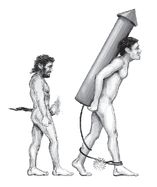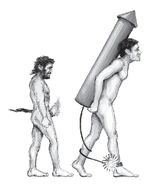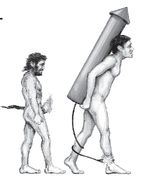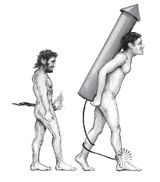The Darwin Awards Countdown to Extinction (19 page)
Read The Darwin Awards Countdown to Extinction Online
Authors: Wendy Northcutt
Reference: Anonymous
The next story features this guy’s identical twin . . .

Unconfirmed Military Account
Featuring the military, a vehicle, and machismo
1973, VIRGINIA | When I was in the Marines, a bottom-enlisted and an NCO were required to stand twenty-four-hour watch together. One evening I showed up for duty to find the NCO, whom we’ll call Todd, limping and covered with dozens of fresh scabs! He was reluctant to reveal what caused his injuries until I promised not to tell. I lived with that promise for thirty years, until now.
This NCO Todd had an NCO friend whom we’ll call Dutch, and these guys would do just about anything for a laugh. The two NCOs ended up working together in the squadron truck and had an idea good for a few laughs.
Dutch was possessed of great upper body strength; he had been a Greco-Roman wrestler in high school and was still an active weight lifter. Dutch would put his elbow outside the open window, hang on to the door under his armpit, and when Todd made a left turn Dutch would open the door and swing out with the centrifugal force of the turn, riding on the door under his arm. Good fun, huh?
These two were having a few laughs with their flying door routine, all well and good, until one turn brought the open door too close to a fire hydrant. The hydrant caught the bottom corner of the door and the door rebounded, slamming shut at over thirty miles an hour and sending Dutch sailing across the vinyl bench seat and slamming into Todd with enough force to knock open the driver’s door and eject him from the vehicle!
Dutch managed to recover the wheel and prevent Todd from being run down. Both men were in pain for weeks, and this being the military, both spent long hours in extra duty. After all, they were guilty of risking U.S. government property.
Reference: Carin Gleason
MAD SCIENCE: PROJECT STEVE
Creationists try to convince the public that evolution is a “theory in crisis” by compiling lists of scientists who doubt evolution. The National Center for Science Education responded with Project Steve.
8
Instead of compiling a list of ten thousand scientists who support evolution, they decided to poke fun at the nuts by compiling a list of only those scientists named “Steve” who affirm the validity of evolution. Steve was chosen in honor of the late Stephen Jay Gould, beloved evolutionary biologist. In March 2010 there were 1,138 Steves on the list! Because Steves comprise only about 1 percent of scientists, Project Steve makes the point that
scientists support evolution.
8
Instead of compiling a list of ten thousand scientists who support evolution, they decided to poke fun at the nuts by compiling a list of only those scientists named “Steve” who affirm the validity of evolution. Steve was chosen in honor of the late Stephen Jay Gould, beloved evolutionary biologist. In March 2010 there were 1,138 Steves on the list! Because Steves comprise only about 1 percent of scientists, Project Steve makes the point that
scientists support evolution.

Unconfirmed Personal Account
Featuring a vehicle and music!
NOVEMBER 2009, POUGHKEEPSIE, NEW YORK | “I was driving down the road when the car in front of me suddenly accelerated, then stopped accelerating but continued going straight as the road curved, ultimately crashing into a rail. I pulled over to help, and asked the driver what caused the crash. He told me that ‘The Cha Cha Slide’ was playing on the radio and he was dancing along. When the lyrics came to ‘Left foot, left stomp,’ he did just that, flooring the accelerator. Then the lyrics commanded, ‘Freeze,’ and he froze, and then, ‘Everybody, clap your hands’—at which point he crashed.”
Reference: Anonymous

Reader Comments
“I told you that dancing was evil!”
“A nearly fatal case of the clap.”
At-Risk Survivor: Cats Land on All FoursUnconfirmed
Featuring work, vehicles, and gravity
8 MAY 2008, CALIFORNIA | Twenty-four-year-old Andrew, an operator for a gravel company, did not intend to perform a death-defying stunt with a forty-ton construction machine. He was only trying to free a bulldozer stuck atop a fifty-foot-high pile of dirt that it had been pushing. Despite several better options, Andrew decided to pull the stuck machine backward with an old front-end Caterpillar loader.
Driving up a dirt ramp at a forty-degree angle is nerve-racking enough without doing so knowing that your vehicle’s brakes are inoperable and in need of repair. The operator in question knew that when he decided to use the machine to free the ’dozer, something he should not have been doing with
any
loader under
any
circumstance. To compound the risk, Andrew decided to improve traction by loading the Caterpillar’s bucket with dirt to give it more weight.
any
loader under
any
circumstance. To compound the risk, Andrew decided to improve traction by loading the Caterpillar’s bucket with dirt to give it more weight.
At the top of the hill, Andrew did as he was trained: He took his foot off the throttle and hit the button to engage the parking brake—forgetting that, on CAT loaders, setting the parking brake automatically puts the transmission in neutral. He unfastened his seat belt and began to exit the loader, which was imperceptibly rolling backward.
When Andrew noticed, he jumped back into the cab and hit the brake pedal, but nothing happened. The loader continued downhill.

Beyond the edge of the property was a steep drop down to the next property. A five-foot dirt berm protected the edge so trucks would not accidentally drive off the cliff. At twenty-five mph, this berm did little to slow forty tons of rolling steel and dirt, but it did give the loader a good launching height. In a stunt that would make Evel Knievel sweat, the machine careened up the berm and launched into the air, clearing the cliff and landing on the adjacent property thirty-five feet below and fifty feet away.
Andrew was thrown through the rear windshield and onto the engine compartment. Miraculously the loader landed on all four tires, and he was able to walk away with just a few cuts and bruises. Looking back at the incident, Andrew laughs and says he proved that
a CAT always lands on all fours.
a CAT always lands on all fours.
Reference: Pending OSHA Report
SCIENCE INTERLUDE LEFT BEHIND: VESTIGIAL STRUCTURES
By Stephanie Pappas
The human appendix is as active as a drowned worm. Just three or four inches long, this dead-end tube dangles off the large intestine in the lower right side of the abdomen. If you were born without one, you will likely never know. Surgically remove it, and you’ll carry on eating and excreting without a hitch. Charles Darwin himself declared the thing “useless.”
Vestigial structures—body parts that have lost their original function but linger on in a rudimentary form—are everywhere. One species diverges from another and no longer needs those pesky gills, extra teeth, or that third eyelid, but the developmental pathways that build those structures soldier on. Unless the vestigial bits and pieces actively harm an organism’s chances for procreation, they simply stick around.
Charles Darwin himself declared the appendix “useless.”

Whale Legs, Pili, and Pinnae
Vestigiality explains weird stuff like whales with leg bones under their blubber, and blind cave fish that form embryonic eyes only to have those eyes collapse and vanish before the fish hatch. We humans experience the effects of evolutionary leftovers every time we feel the prickle of gooseflesh. When we’re cold or scared, tiny
erector pili
muscles at the base of each hair follicle snap to attention, and—
BAM
—goose bumps. It’s a nice reflex if you’re a German Shepherd, but doesn’t do much for
Homo sapiens
.
erector pili
muscles at the base of each hair follicle snap to attention, and—
BAM
—goose bumps. It’s a nice reflex if you’re a German Shepherd, but doesn’t do much for
Homo sapiens
.
The
erector pili
is not the only body part whose heyday has passed. Certain small muscles in our forearms and feet are vestigial remnants of larger muscles that helped our ancestors swing on branches. Wisdom teeth are a reminder of a time when jaws were larger and teeth more likely to need replacing. Muscles around our ears helped a long-ago ancestor swivel the organs toward faint sounds, but today they’re useful only for the occasional ear-wiggling party trick.
erector pili
is not the only body part whose heyday has passed. Certain small muscles in our forearms and feet are vestigial remnants of larger muscles that helped our ancestors swing on branches. Wisdom teeth are a reminder of a time when jaws were larger and teeth more likely to need replacing. Muscles around our ears helped a long-ago ancestor swivel the organs toward faint sounds, but today they’re useful only for the occasional ear-wiggling party trick.
Ear muscles are today useful only for party tricks.
Peer Into the Past
While vestigial structures are a fine tool for evolutionary biologists trying to tease out the connections between species, if you
really
want to understand our ancestry, it’s best to peer into the genome itself.
really
want to understand our ancestry, it’s best to peer into the genome itself.
As it turns out, that genome is a messy place full of evolutionary leftovers.
Our DNA is a hodgepodge of mutations, recombinations, and genetic cut-and-paste. Among the remnants of this process are
pseudogenes,
which resemble functional genes but don’t code for proteins the way functional genes should. Some pseudogenes are broken pieces of genes that have since vanished—no functional versions are found. Other pseudogenes are old copies of genes that have evolved into newer, functional versions. These “backup copies” are a snapshot of what once was.
pseudogenes,
which resemble functional genes but don’t code for proteins the way functional genes should. Some pseudogenes are broken pieces of genes that have since vanished—no functional versions are found. Other pseudogenes are old copies of genes that have evolved into newer, functional versions. These “backup copies” are a snapshot of what once was.
Pseudogenes are fossils of old DNA that show us what once was.
Other books
The Price Of Dick by Dan Skinner
The Pathfinder Project by Todd M. Stockert
Public Property by Baggot, Mandy
The Protect Her Box Set: Parts 7-9 by Ivy Sinclair
Team Mates by Alana Church
Spike: (#3.5 The Beat and the Pulse) by Amity Cross
Memorial Day: A Mick Callahan Novel (The Mick Callahan Novels) by Harry Shannon
The Complete Novels of Mark Twain and the Complete Biography of Mark Twain by A. B. Paine (pulitzer Prize Committee), Mark Twain, The Complete Works Collection
2009 - Ordinary Thunderstorms by William Boyd, Prefers to remain anonymous
Godless by James Dobson